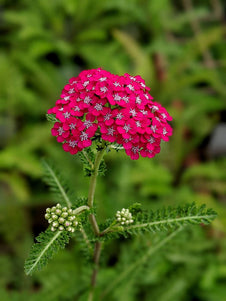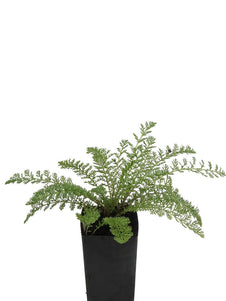







Yarrow Red
Yarrow Red

- Low stock - 20 items left
- Inventory on the way

Usually available: All year
Life cycle: Perennial
Height: 20 - 60cm
Position: Full sun
Soil preference: Well drained
This is how we pack and send your Herb Plants to all states except TAS & WA
You will receive
- 1 Yarrow Red Herb Plant in a 50 X 75mm tube - General growing instructions
All of our Herb Plants are grown organically with certified organic potting mixes and fertilizers
Botanical Name: Achillea millefolium
Red Yarrow is an herbaceous, mat forming perennial growing from 20 cm to 60 cm, depending on the specific variety or sub species. However, the foliage remains low with most of the height obtained from the long flower stalks. The green-grey leaves are 5-20cm long with a bipinnate or tripinnate form and are covered in small hairs, which accentuate the feathery appearance of the foliage. The leaves at the base and up to the middle are the largest and they are arranged in a spiral around the stem. The species name ‘millefolium’ is derived from the large number of segments in the foliage. The flowering period is from summer to autumn, with the red flowers appearing in flat clusters or corymbs at the top of the plant.
Red Yarrow is often called Common Yarrow, but the original flower colour was generally white or cream. Today there are many modern cultivars with different flowers colours, including red. Yarrow plants are in the Asteraceae family and belong to the Achillea genus, which has over 80 species. These plants live in native habitats across Europe and Asia, with some growing naturally in North America. Depending on the species or sub species, they range in height and have white, yellow, orange, pink, or red flowers held in a characteristic corymb or flat cluster at the top of the stem. There are many modern cultivars that lend a cottage garden feel to any modern garden.
There is much folklore about the Yarrow family, although which species is involved may sometimes be quite vague. The name Achilles is said to be derived from the Trojan War when the hero Achilles was taught by Charon the Centaur to use the leaves of yarrow plants to heal his soldier’s wounds. Thereafter, soldiers carried yarrow through wars for many centuries and helped to create the popular name of Soldier’s Woundwort. Other older names include Knight’s Milfoil, Bloodwort, Nosebleed and apparently The Ancients also knew of the healing properties and called yarrow by the name Herba Militaris, the military herb. Yarrow was also considered to have magical attributes and was used for divination, spells and for protecting loved ones.
Growing Conditions
Yarrow is a hardy plant and although it may look delicate, red yarrow will do more than just survive in poor conditions. Yarrow prefers sandy soil, or other soils with good drainage for best results. If you have a bare place, where nothing else will grow there is a good chance that yarrow will prosper. Very rich soil may lead to the plants growing too tall, so they may require staking as the stalks will not support the flower heads. Full sun is ideal and with average to low water requirements, red yarrow is drought tolerant. Pruning the flowers heads will result in a new flush of flowers. Red yarrow will drop its seeds after flowering and reappear the following year. However, if more controlled propagation is desired, the plant may be divided or cuttings may be taken. The plant will spread naturally by the underground rhizomes, creating thick clumps.
Medicinal Uses
Achilles millefolium, Red Yarrow, has a strong history of medicinal use and is also said to intensify the healing work of other herbs. In particular, Red Yarrow was used externally to help stop bleeding and to help skin heal naturally. It is also known to have effects on the cardiovascular system, to be astringent, antiseptic, anti-inflammatory, sedative, and have many other direct actions on the body. Red Yarrow tea is often used for treating colds and flu symptoms and as a general tonic.
Red Yarrow has been used a ‘women’s herb’ for many centuries to ease the pain of menstrual cramping. However, it should not be used by pregnant women due to the possibility of uterine contractions. Over 100 active chemicals have been identified in the yarrow plants with many being investigated for use in modern medicine. There is also significant potential for Red Yarrow to interact with any modern medicines, including those related to blood clotting and normal painkillers. Please see further information about these interactions and contraindications on our Woolly Yarrow page, which notes medicinal actions for the yarrow family.
To harvest the plant for use, wait until flowering and pull out the whole plant for use, including the flowers. If the flowers are not desired then harvest leaves prior to flowering as this is when they have the strongest concentrations of active components.
Culinary Uses
The young leaves may be harvested and used in salads, although they seem to taste better cooked. The leaves may be added to stews, soups or even fried with other vegetables. The older the leaves get the more bitter they will taste.
Other Uses
Yarrow is said to be a good companion plant, attracting desirable insects and repelling others. The flowers do well as both cut and dried flower arrangements. A handful of yarrow leaves will help break down compost.
All information provided on this website is for informational purposes only. Please seek professional advice before commencing any treatment.





